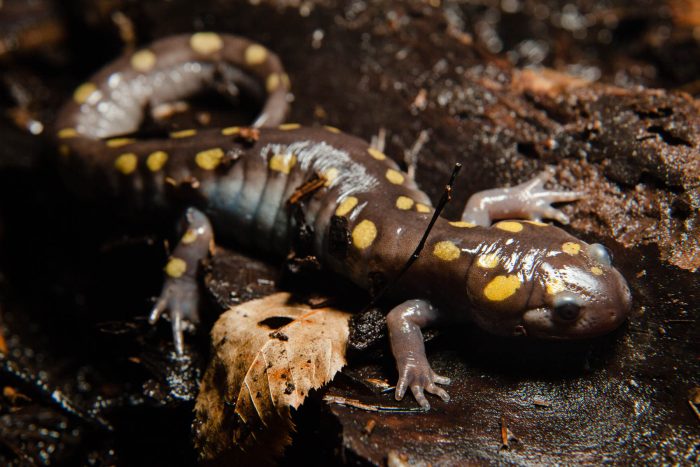Spotted Salamander
Ambystoma maculatum
Spotted salamanders are grey, black or bluish and live in all of Chesapeake Bay watershed except the Delmarva Peninsula. They spend most of their lives sheltered under leaf litter, logs and rocks.
This section shows one large critter image at a time. Use the thumbnails that follow to select a specific image to display here.

This gallery contains a grid of small thumbnails. Selecting a thumbnail will change the main image in the preceding section.
Appearance
Adult spotted salamanders range from 6 to 9 inches in length. Females grow larger than males. They have stout bodies and rounded snout with large, strong legs that have four to five toes. The two rows of yellow or orange spots along their backs contrast with a dark grey, black or blue base color.
Feeding
Larvae are aggressive predators that will eat any small animal they can catch. This includes tadpoles, insects, other salamander larvae and even members of their own species if food supplies are scarce.
Adults use their sticky tongues to catch invertebrates found on the forest floor, including earthworms, snails, slugs, millipedes, centipedes, insects and smaller salamander species.
Predators
Newts and crayfish feed on eggs. Aquatic insects, fish, wading birds, other salamander species and snakes feed on larvae. Skunks, raccoons, turtles and snakes feed on adults.
Voice
Spotted salamanders communicate by smell, sight and touch. They rarely vocalize unless under attack.
Reproduction and life cycle
Breeding takes place at the end of winter, after the ground thaws. Adults migrate to freshwater breeding pools in response to the first spring rains, with males arriving first. There are more males in each breeding pool than females. Males compete for mates by rubbing, bumping and nosing into each other.
Males produce droplets of sperm that females take in to fertilize eggs. Males can fertilize several females, and females can take in sperm from several males. Females produce 100 to 300 eggs per year, laying egg masses under water and attaching them to submerged objects.
Eggs hatch in four to seven weeks. Larvae are a dull olive-green and are born with gills. Larvae transform into juveniles in two to four months, losing their gills and moving to land. Juveniles mature into breeding adults in two to three years.
More than 90% of offspring die before they leave their pond, due to predation, disease and ponds drying up. Adults can live for 20 to 30 years.
Did you know?
- Spotted salamanders return to the same breeding pool every year.
- They spend most of their time hidden under leaf litter, logs and rocks.
- Their bright spots act as a warning sign to predators that the spotted salamander produces toxic secretions behind its head and tail.
- It is believed that algae and salamanders have a symbiotic relationship. Salamanders' egg sacs provide a safe place for algae to grow; in return, the algae produces oxygen for embryonic development.
- Unspotted individuals occur, but are rare.
Sources and additional information
- Ambystoma maculatum – University of Michigan Museum of Zoology
- Spotted Salamander – Savannah River Ecology Laboratory
- Spotted Salamander – National Geographic
